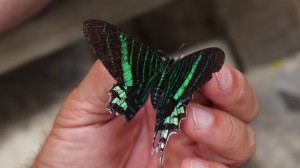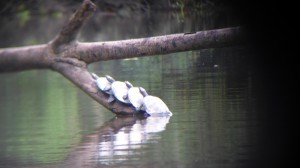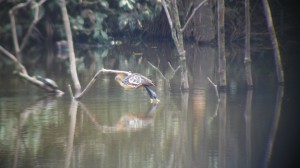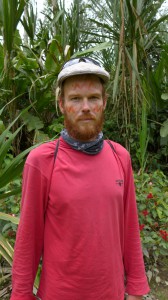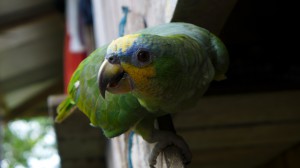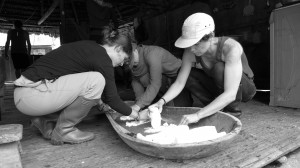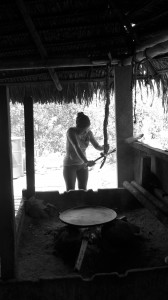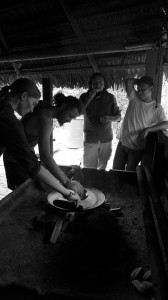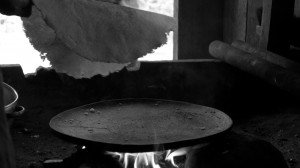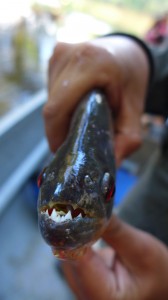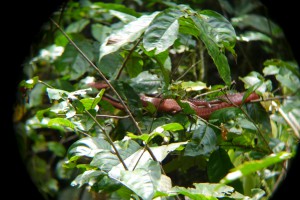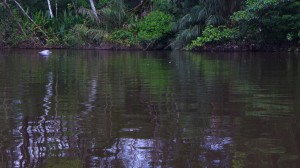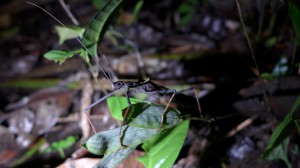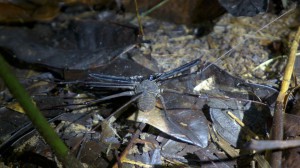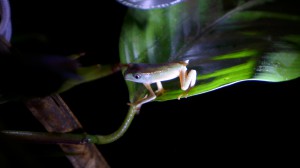The trip started with a bus ride to the Carcelen terminal, from where a night bus would take me to Lago Agrio. I could sleep a little and, while still feeling battered, the start into the morning was alright. I spent some time looking for a small bag, as i am travelling without a bagpack and so it came to pass that i’m now the owner of an ’emelek’ bag, the name of the soccer team from Guayaquil. The group met at a restaurant where other people were also waiting to be picked up. After a two hour bus ride we arrived at the end of the road, from where further progress into the national park is only possible by boat. During the lunchbreak we experienced heavy rain, and while it continued to do so during the first half of the trip, it was nothing compared to earlier when it took us ten minutes to muster the courage to overcome the five meters to get back to the bus. At the beginning we encountered some large ferries loaded with cars and even huge trucks, but the further we went down the Rio Aguarico and then turning off to the Rio Cuyabeno, the less boats we encountered.
When we arrived at the lodge, another group readied themself for some jungle adventure. We weren’t too disappointed not to share in this activity after around twenty hours of travelling. The lodge is simple, yet comfortable and besides the clearing for the huts, the rainforest around it is almost untouched.
The mornings started with watching animals directly from the lodge while, either waiting for all people to get ready for a trip or for breakfast. Some groups of monkeys were passing by, frogs could be found in our bungalows and one person even had a net to catch butterflies for a closer inspection before letting them go their way.
Some of the animals were far away and we used our cameras in combination with the binoculars to get a better shot. Our daily visitors included these turtles, which in this photo look squeezed together like after a traffic accident rather than enjoying a relaxed sunbath.
Or the hoatzin, which is a descendant from one of the earlist birds on this planet, the archaeopteryx.
One afternoon we visited a indigenous family who still upholds the traditions of the region and we learned how they use the plants of the area for construction, their kitchen utensils, as food source and as a dye, which our guide demonstrated.
We saw lots of birds which were too far away to take a good photo without a strong tele. Soon we stopped hunting for photos and were rather taking in the atmosphere and were content with the views through the binoculars. But at the home of the family, we could make up for the missing photos with their pet bird.
I don’t know anything about wing clipping, but i didn’t see that animal fly and have only seen it climb along the stairs while clinging to the wood with its beak.
We spent the day walking around the plantations and then learned about the process of making pan de yuca. We cut down a yuca tree and extracted the roots from the ground, then washed and grated them.
The water had to be squeezed out which the lady of the house did with the help of a net-like contraption made out of the bark of a special tree,
before the yuka flour was put on a hot clay plate, spread and compacted with the help of a wooden spatula and one half of a fruit-shell, not unlike that of a coconut.
and without addition of any other ingredients was baked into a tortilla.
On a small table, chocolate, pineapple jam and a some spicy salad were offered with it as a snack. More food could be found in the water, and on our way back captain Fabian caught a piranha so we could have a look at these teeth up close.
The meals in the lodge were usually local dishes and the cook explained before each meal what we were about to eat. During one dinner, questionaires were handed to the people who were to leave the next day to help improve the trip experience with their comments. Somehow i was handed one as well and filled it out a little to early, as my comment on improvements included the wish for an unmotorized canoe trip and the next day we had two of them. With just paddles we went exploring small sidestreams with overhanging vegetation and sometimes obstacles like fallen trees in the water which we had to overcome with speed or with simply pushing the canoe over it. The reward were some animals we hadn’t seen so far like this snake.
Our local guide introduced us to some medicinal trees, from which the bark is used to cure stomache aches while other plants were used for birth control. There is even a tree whose bark is supposed to help overcome a hangover. And of course the ayahuasca, which helps the shaman to reach a state of mind in which the medicinal use of plants are revealed to him to cure the sick.
The last morning before leaving Cuyabeno was dolphin day. First we saw a single grey one and then a group of three pink dolphins. Their only showing a small part of their body while they surface to breath.
Their name comes from the change of colour they undergo when they swim large distances, not unlike our red cheecks we get while doing sports. The dolphin quickly built up a reputation among our group of being anything but a tame cutie. After our guide told us he eats caymans up to a certain size, as well as battling the paiche, with a size up to three meters the biggest fish in these parts, nobody felt like swimming with dolphins anymore.
Though we had already hunted for caymans while out in the canoe once during the night, we had another chance to see them around the lodge. The cook was throwing rests of chicken in the water and after glowing orange eyes were moving closer almost without a sound, we could see more of the animals while they were swallowed the pieces of meat. During the following nightwalk we saw more animals up close as they didn’t seem to mind our presence or the flashlights much. Very common were large antennas.
Here a scorpion spider.
And some frogs which added their voice to the nightly orchestra.
Before taking the boot to leave Cuyabeno, we had a swim in the river as well as some fun with the swing rope and didn’t mind if any piranhas or pink dolphins were in the murky water around us.
